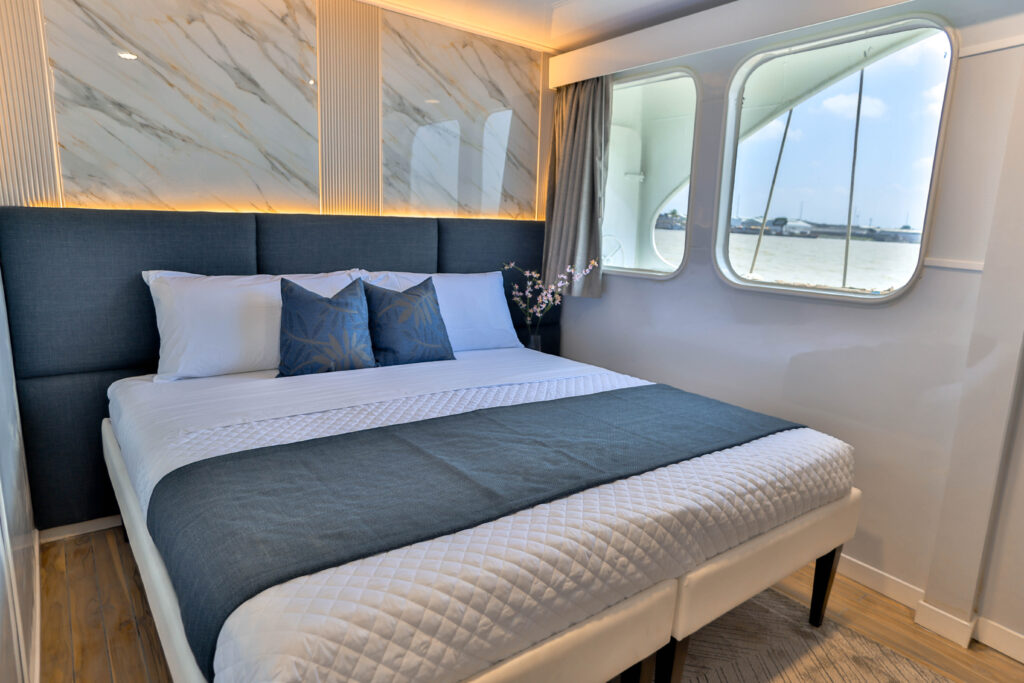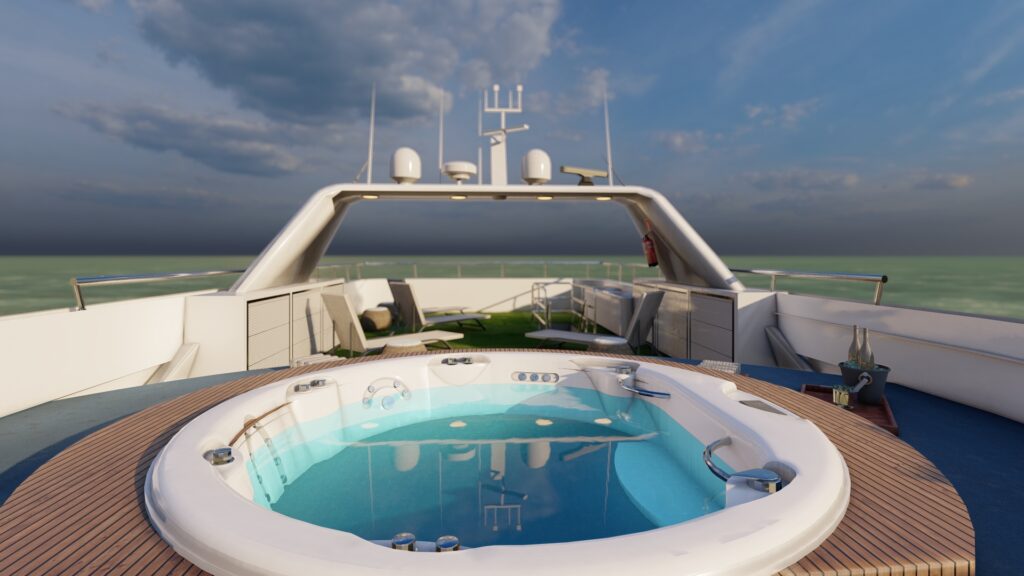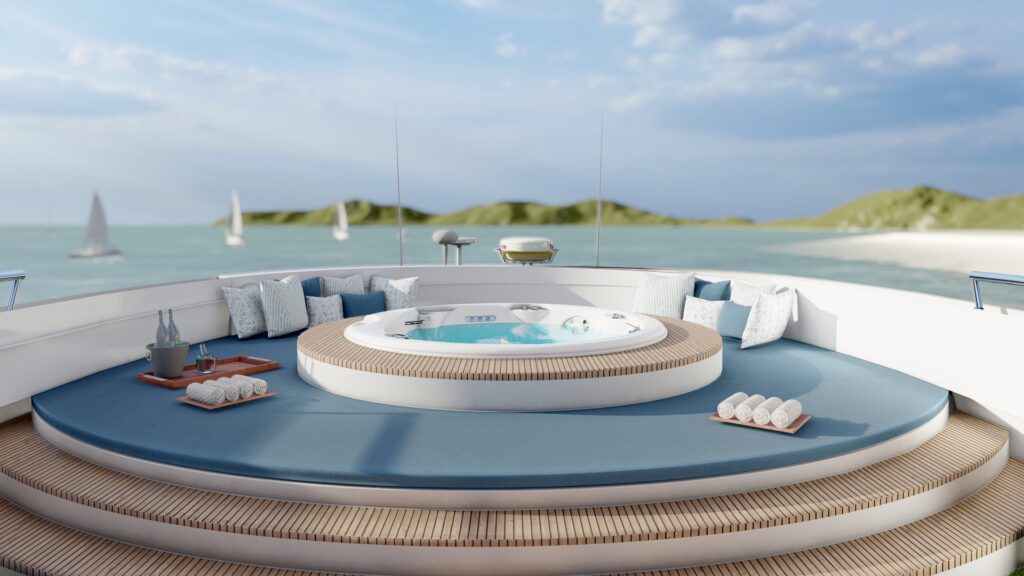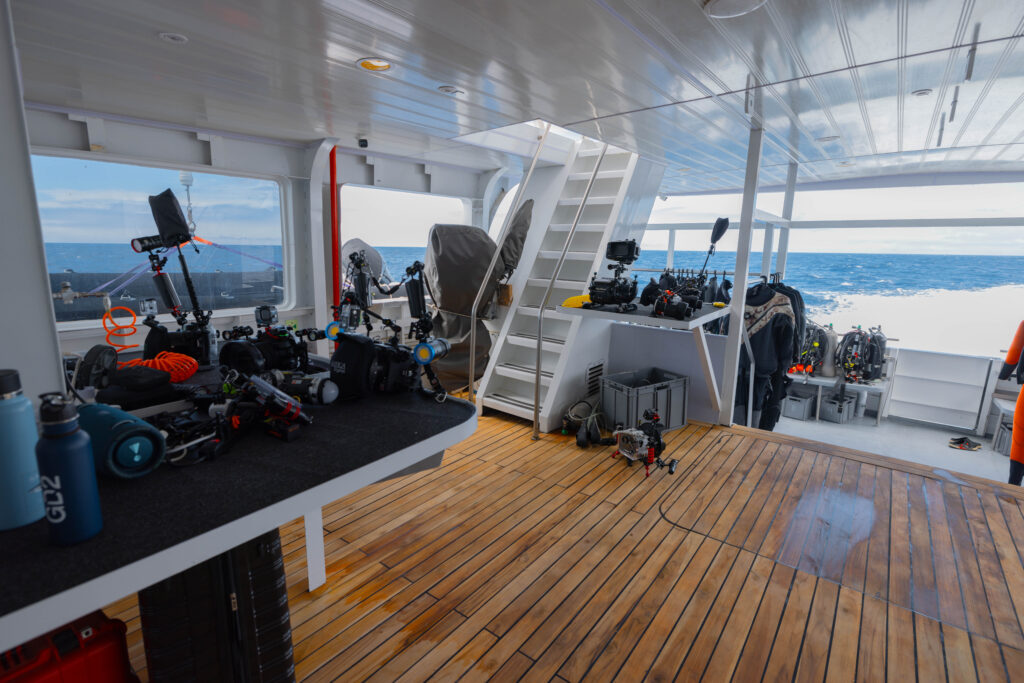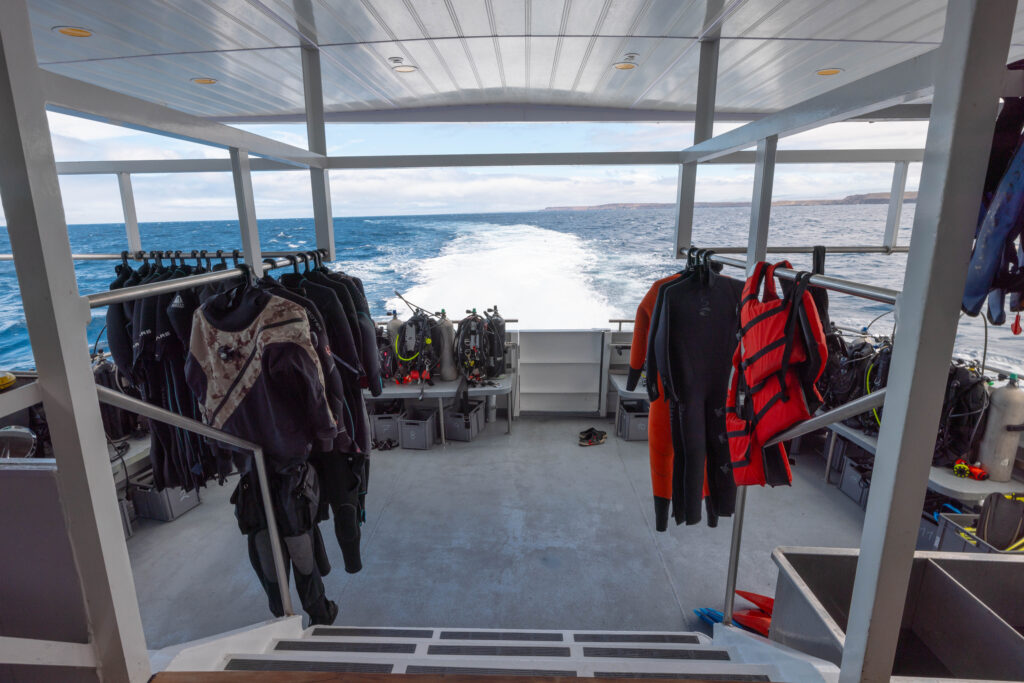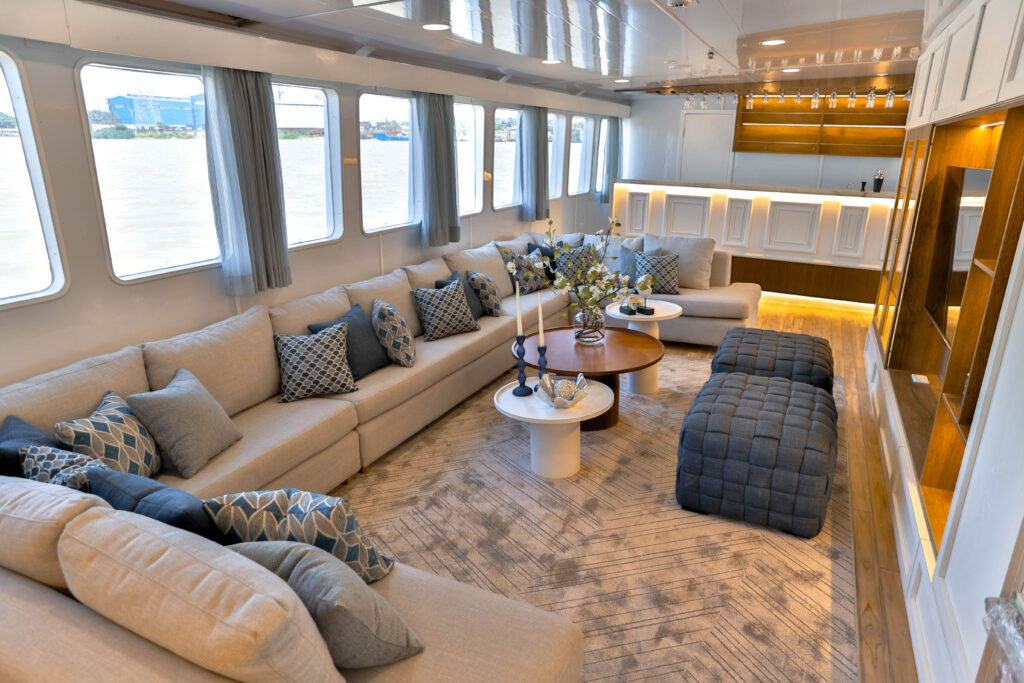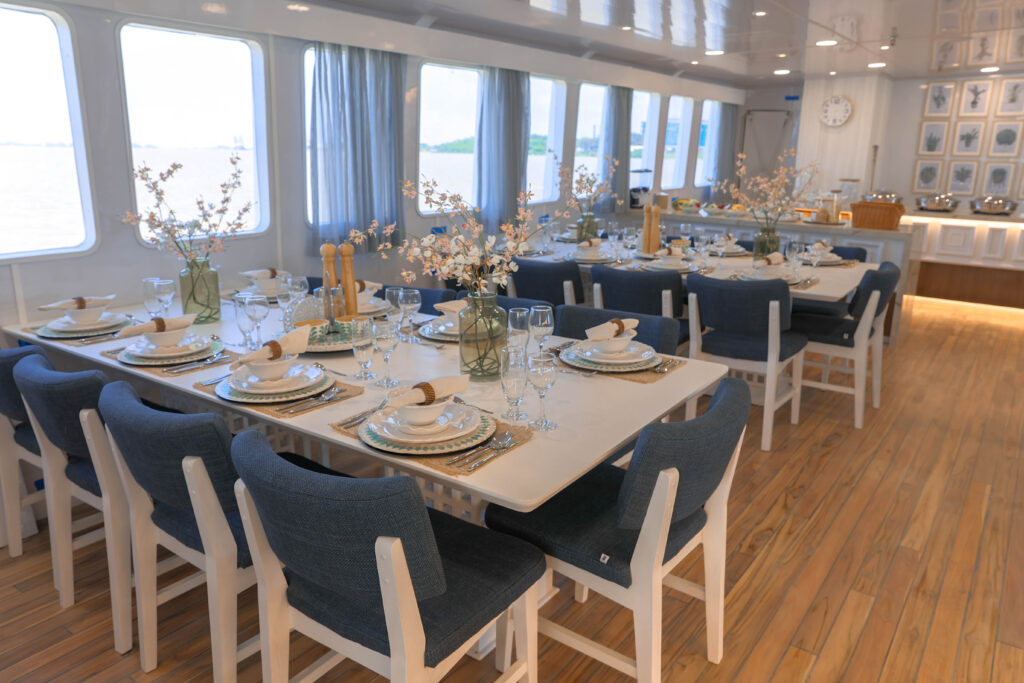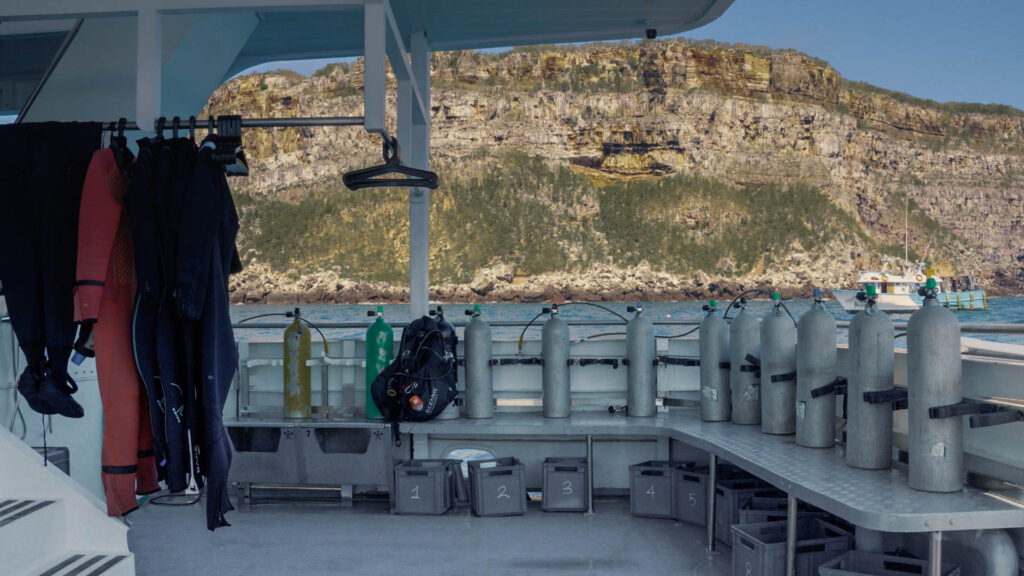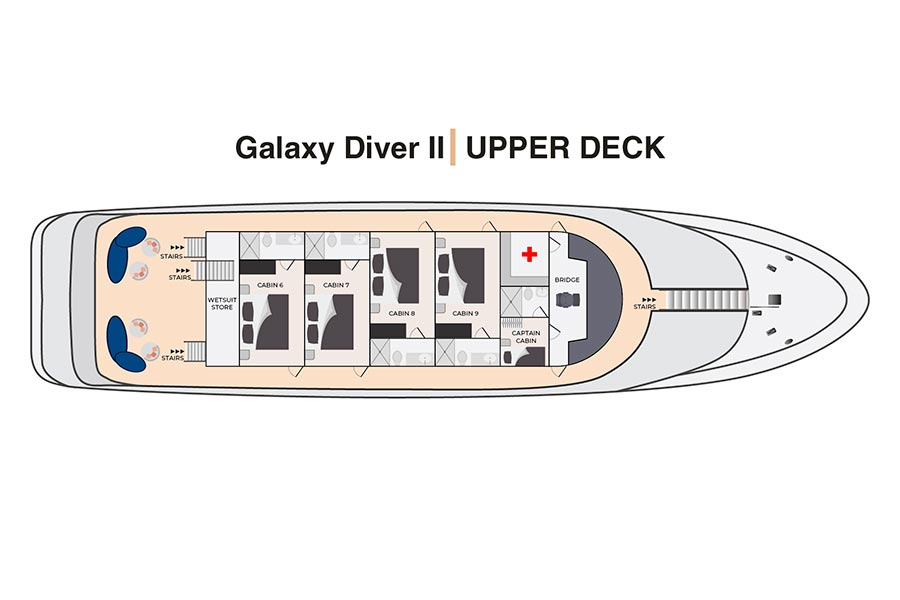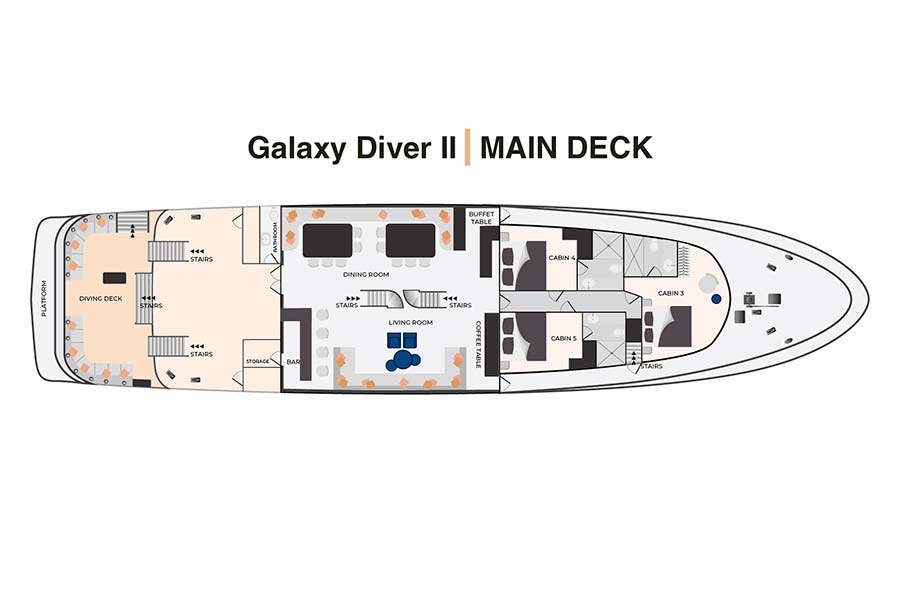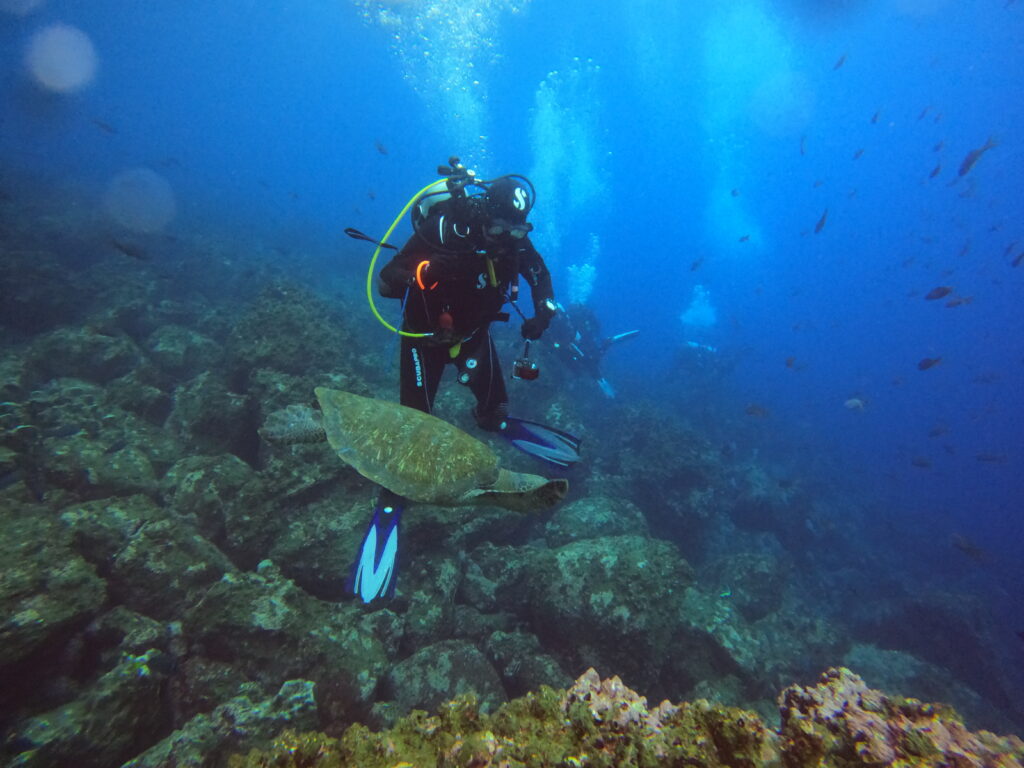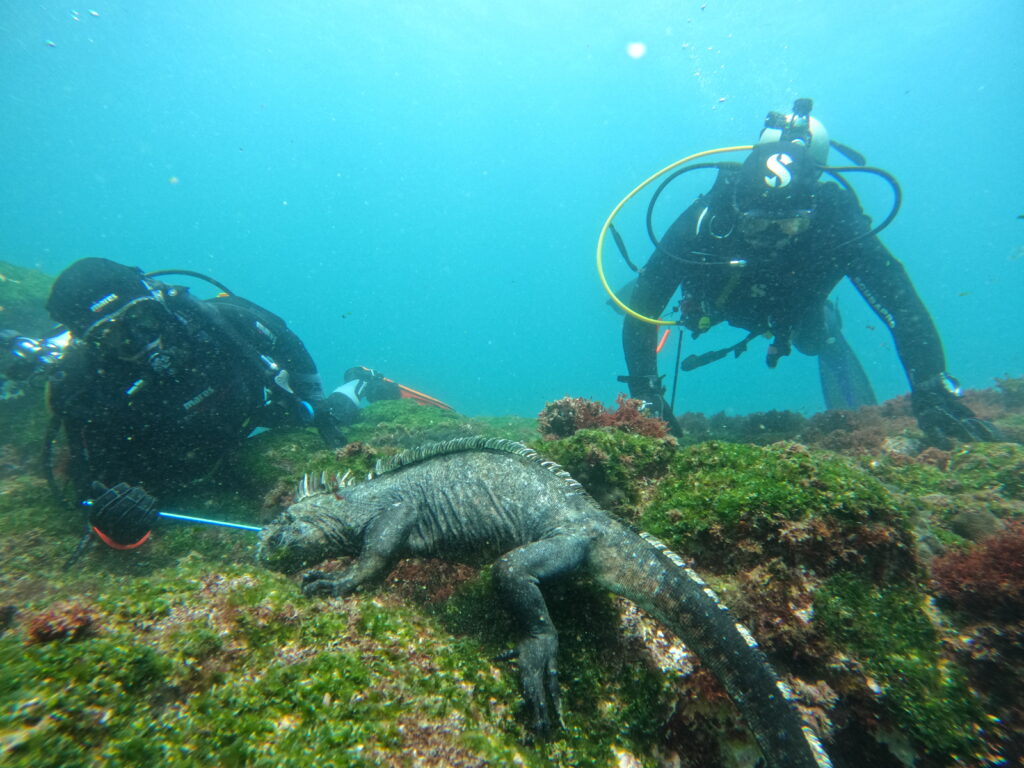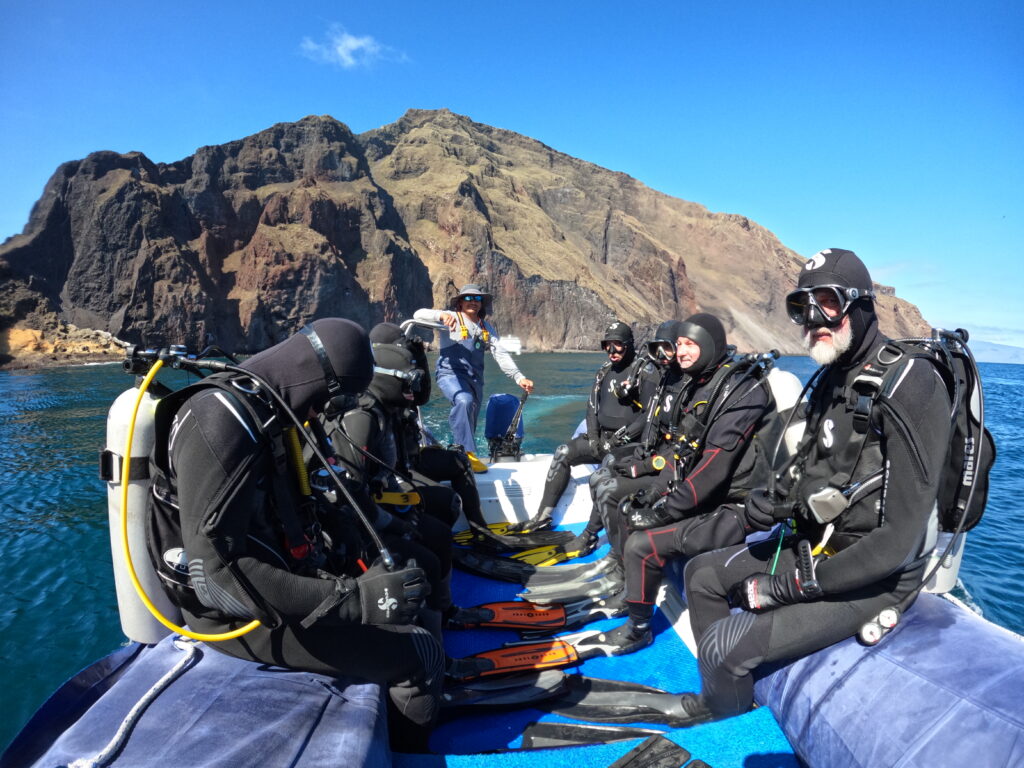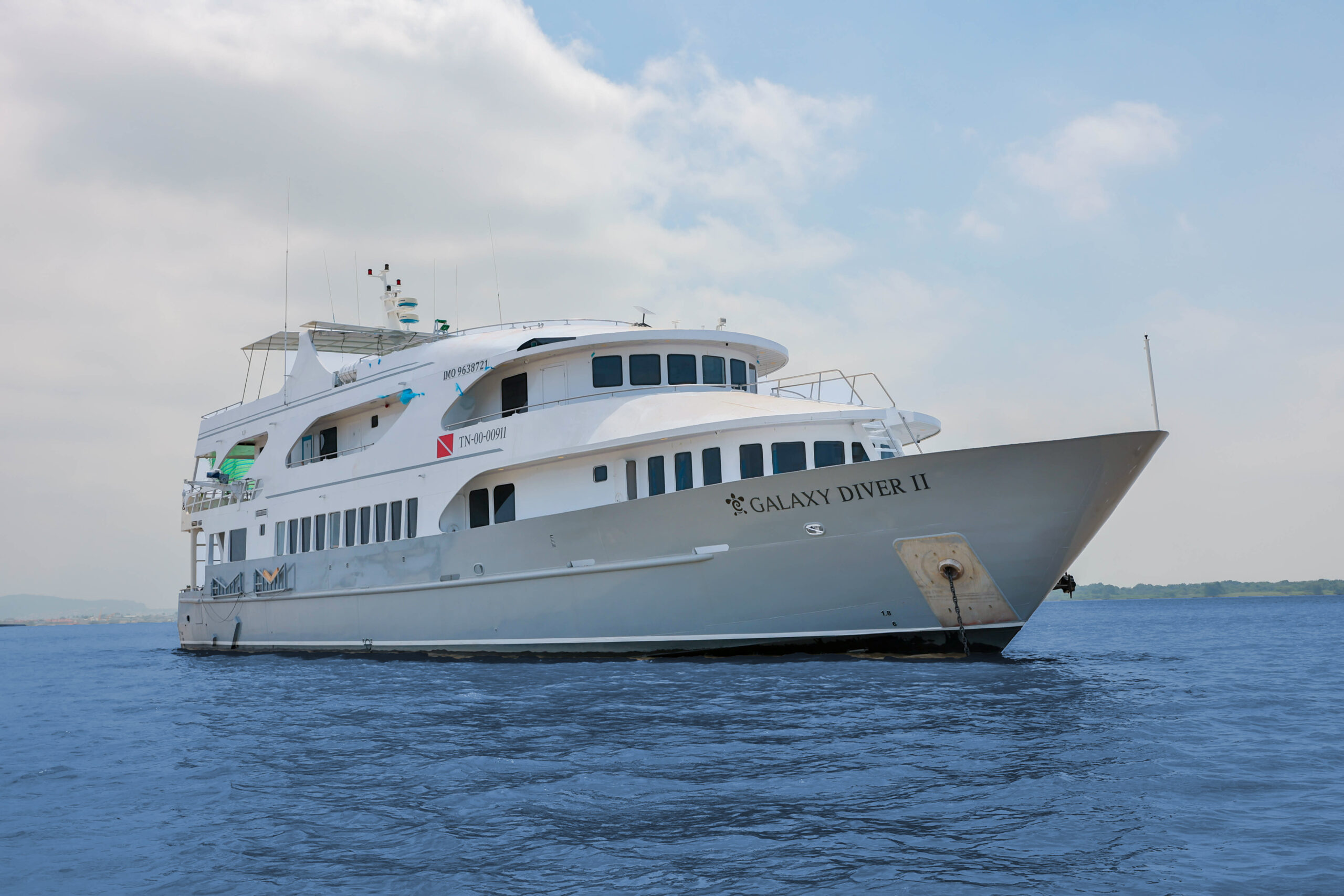
Cabin Price
Start at $633
Departure
Port of Baltra
Destination/Type
Galapagos Liveaboard
Highlights:
The Galaxy Diver II recently underwent a meticulous redesign. This luxurious motor yacht specializes in thrilling diving expeditions and educational naturalist cruises around the Galapagos Islands. Guests can indulge in delicious, freshly-made meals and the boat offers complimentary nitrox for certified divers. Designed for comfort, the vessel promises an unforgettable eight-day journey through this world famous archipelago. Divers will be well looked after by the knowledgable crew, and can expect to experience close encounters with hammerhead sharks, marine iguanas, manta rays, penguins, sea lions, and other fascinating wildlife. After diving, guests can relax in the state of the art jacuzzi. Every trip on the Galaxy Diver II is a memorable experience, topside and underwater!
Features:
Cabins
8 CabinsDuration
7 NightsNitrox
IncludedTrip Inclusions/Exclusions
Accommodations
Nitrox
All meals during the cruise
Unlimited purified water, coffee and tea
Up to 3-4 dives daily, compressed air, tanks, weights, and weight belts, and we have 2 Dive Masters AKA guides (ratio is 7:1).
Snorkel Gear (mask, tube and fins)
Kayaks and Paddle Boards without any additional cost
Long Wetsuits (3mm)
Airport assistance from Quito or Guayaquil in order to help travelers with logistic manners.
Once guests arrive at Galapagos and after passing customs they will see the National Park Guide with the yachts´ name banner ready to take them to the shuttle towards the first activity depending on their itinerary.
Transfers in Galapagos (Once guests arrive at Baltra airport our tour guide will be waiting in order to take them to the boat)
Biodegradable amenities: shampoo, conditioner & soap
Lock box (except M/Y Bonita)
Hair dryer (except M/Y Bonita)
Outlets: 110v/220v
We guarantee the same gender for cabins willing to share
Naturalist Bilingual Guide (English)
If you need a special guide like bird watching/photographer or someone who speaks in another language, ask our prices and availability. Service for charters and FITs.
All visits & excursions according to the itinerary
Local flight to/from Galapagos (handling fee for not issuing with us US$ 60 per person)
Galapagos National Park Entrance fee ($200 per person)
Galapagos Transit card ($20 per person)
Alcoholic drinks
Tips
Local Taxes
Travel Insurance
Gratuities
Join our newsletter and receive $100 credit
7 Nights - Diving
Itinerary is subject to change
Arrival at the Gateway to the Enchanting Galapagos Islands Welcome to the Galapagos Islands, where today marks the beginning of our diving adventure onboard the Galaxy Diver liveaboard yacht. Our journey starts with our arrival at Seymour Airport, also known as Baltra Airport, located on the island of Baltra. As we step off the plane, we'll be greeted by our guide and the friendly staff of the Galaxy Diver, who will help us with our luggage and transfer us to the Galaxy Diver.
Then, we'll enjoy a delicious lunch and settle into our cabins. But before we dive into the waters, it's important to note that there are strict guidelines for passengers to the archipelago due to the area's designation as a national park. These guidelines help preserve the delicate environment of the Galapagos Islands, ensuring that we can continue to enjoy the beauty of this unique ecosystem for years to come.
After all, we have the safety drill and check dive to try all the equipment by having our first immersion among the wonders of the Galapagos Islands. With the Galaxy Diver as our home base, we'll explore the pristine waters and encounter incredible marine life that can't be found anywhere else. It's sure to be an unforgettable experience that will leave us with memories to last a lifetime.
Carrion Point and en route to Wolf Island - A Diver's Paradise As the sun rises on our first day of diving aboard the Galaxy Diver yacht, we can feel the excitement building for what's in store at our first dive site, Punta Carrion. We gather our gear, and with the guidance of our expert dive master instructors, we dive into the crystal-clear waters surrounding the stunning Santa Cruz Island. Descending deeper into the underwater world of Punta Carrion, we'll be immediately mesmerized by the incredible visibility and the abundance of marine life that surrounds us—schools of hammerhead and whale sharks, this last one available between June to December. At the same time, playful sea lions dart in and out of the rocky underwater cliffs.
We learn more about the vivid and colorful world of tropical fish as we continue our exploration, including groups of surgeonfish, angelfish, and parrotfish. Luckily, we can even find a few secretive seahorses hidden in the reef's crevices.
Later, we joyfully discuss our underwater excursions. At the same time, the onboard cook makes a lovely lunch when we return to the Galaxy Diver. Finally, in the late afternoon, we'll begin our 14 hours of navigation through the Galapagos Sea to Wolf Island
Shark Bay, La Banana, La Ventana Islet, and El Derrumbe - A Magnificent Marine Expedition Today, we'll have an exciting diving adventure as we discover the hidden riches of this enchanted location. Our first stop is the breathtaking Shark Bay, where we can spot the majestic Galapagos shark, eagle ray, and sea lion will meet you as you plunge into the ocean's depths. These magnificent creatures are a sight to behold, with exquisite movements that will take your breath away.
Following a thrilling morning dive, we'll travel to La Banana to continue our journey and discover the Galapagos Islands' abundant marine life. In addition, we'll be able to see playful sea lions in their native environment, darting and whirling about us with elegant, engaging, and mesmerizing beauty. As the day unfolds, we'll make our way to La Ventana Islet and El Derrumbe, two diving locations known for their diverse marine life. Go into the fascinating world of colorful fish, turtles, and sea stars as they welcome you into their natural home. The beauty and magic of the undersea environment will wow you as you explore these hidden jewels. As we wrap up our diving day, take a minute to enjoy the beautiful sunset while reflecting on the incredible experiences of the day. The Galapagos Islands are indeed a treasure trove of natural beauty, and we are privileged to accompany you on this magnificent voyage. Therefore, be ready to immerse yourself in a world of wonder and go on a once-in-a-lifetime experience!
Today, we'll take you to El Arenal. This magnificent location will leave you spellbound by the natural beauty of the Galapagos Islands. A diving site considered one of the best diving points in the world. This site is close to Darwin's Arch and offers moderate to strong currents with depths ranging from 46 to 121 ft and visibility from 40 to 80 ft. As you dive deeper into the sea, you'll be greeted by the impressive Galapagos underwater biodiversity. We'll then move on to Darwin's Tower, commonly known as Darwin's Arch, one of the most iconic dive sites in the world. This awe-inspiring location is a must-visit for any avid diver. We're thrilled to share this incredible experience with you. As you dive into the deep blue waters, a world of vibrant coral, schools of colorful fish, and the majestic beauty of the hammerhead shark will be waiting for you with their imposing presence and graceful movements. The thrill of diving at Darwin's Tower is indescribable, and you'll be amazed by the sheer beauty of this underwater wonderland.
El Arenal, El Derrumbe, and Shark Bay - A Marine Adventure Our first dive site of the day is El Arenal. As we explore the vibrant coral reefs and discover the diverse marine life, we'll have the chance to encounter an incredible array of species. Some of them could be dolphins commonly sighted feeding on schools of fish, hammerhead sharks, whale sharks, rays, Galapagos sharks, and even tiger sharks and killer whales. But the beauty of El Arenal isn't just in its impressive marine life; the geological formations are also a sight to behold.
After an exhilarating morning dive, we'll move on to El Derrumbe, where we'll discover the fascinating marine diversity of the Galapagos Islands. This site offers a unique diving experience with its underwater cliffs and caves. You'll encounter many species, including green turtles, sea lions, and eagle rays. But what makes this site truly special is the presence of bull sharks, one of the few places in the world where you can dive with them in shallow waters.
Our last dive of the day takes us to Shark Bay, where we'll explore the hidden treasures of the Galapagos Islands. This site is famous for its incredible diversity of marine life, including the Galapagos shark, eagle ray, and sea lion. But what makes this site truly unique is the presence of whale sharks that visit the Galapagos Islands every year from July to November. It's a rare opportunity to witness these gentle giants, and we're honored to share this experience with you.
Marshall Cape is an iconic location in the Galapagos Islands, especially known for its majestic volcanic walls that plunge into the ocean's depths. This underwater landscape becomes a sanctuary for large schools of fish and graceful manta rays that dance in the waters. Popular among divers, Cabo Marshall, as it is known in Spanish, offers a unique diving experience, thanks to the currents and the rich biodiversity these waters house. Diving: Its volcanic walls provide shelter to various marine species. It's not uncommon to encounter schools of hammerhead sharks, barracudas, and, of course, the elegant manta rays that call this spot home. Highlights: Underwater volcanic walls, manta rays, schools of fish, and hammerhead sharks.
City of the Mantas: It's one of the hidden gems of the Galapagos Islands, a site that, as its name suggests, is famous for its encounters with manta rays. This destination offers visitors the chance to immerse themselves in a deep blue world, where giant manta rays, along with other marine residents, glide gracefully and majestically. The area, besides being a sanctuary for these creatures, is a biodiversity spectacle, with colorful corals and tropical fish complementing the scene. Diving: Provides an even more intimate experience with marine life, where the sensation of floating among manta rays becomes a tangible reality. Highlights: Manta rays, rich coral reefs with diverse marine fauna.
Cousin Rock and Santa Cruz Highlands - An Adventure to Remember This morning we'll have the opportunity to do our last dive at Cousin Rock—one of the most colorful dive sites in the archipelago. The vibrant coral walls and gorgonians create a stunning backdrop for encounters with seahorses, reef fish, and various nudibranchs. Keep an eye out for the curious coral hawks as they dart around the reef. As we dive deeper, we might glimpse a school of eagle rays gracefully gliding by or spot a white-tip shark resting in a crevice. If we're lucky, we might even see mobulas and schools of barracudas. Finally, the playful sea lions will appear and invite us to join their underwater games.
After lunch, we disembark and head for a reserve in the Santa Cruz Highlands. Here, we have the unique opportunity to witness the iconic Galapagos Tortoise in its natural habitat. Walking through the lush vegetation, we might even spot some of the other residents of the highlands, like the elusive Galapagos Rail or the bright Vermilion Flycatcher.
Baltra Airport - A Farewell to the Enchanting Galapagos Islands After a week of unforgettable experiences, it is time to bid farewell to this enchanting land. As you'll be transferred to Baltra Airport, take the memories of a lifetime and the magic of the Galapagos Islands.
7 Nights - Naturalist Trip
Great option for snorkelers
Arrival at the Gateway to the Enchanting Galapagos Islands
Welcome to the Galapagos Islands, where today marks the beginning of our adventure onboard the Galaxy Diver liveaboard yacht. Our journey starts with our arrival at Seymour Airport, also known as Baltra Airport, located on Baltra Island. As we step off the plane, we'll be greeted by our guide and the friendly staff of the Galaxy Diver, who will help us with our luggage and transfer us to the Galaxy Diver. Then, we'll enjoy a delicious lunch and settle into our cabins. Bachas gets its name from the remains of two large barges (mispronounced by locals as “bachas”) left by the Americans during WWII. At low tide, you can still see the iron skeletons of the barges buried in the white sand. From November to May, this place is also one of the most important sea turtle nesting grounds in the entire Galapagos islands. There are also several small saltwater lagoons where we often see flamingoes, herons, and other aquatic birds.
Sullivan Bay & Rabida
Embark on a journey of discovery as you hike amidst the volcanic islands, each step unveiling the mysteries of their formation. Here, you'll traverse an exceptionally preserved Pahoehoe lava flow—Marvel at its intricate textures – a sight restricted to only a handful of global locations. Though the landscape may initially seem devoid of life, a closer inspection will reveal nature's resilience. Spot the pioneer plants, the darting lava lizards, and the avian inhabitants, small yet full of life. Next, exchange your hiking boots for flippers as the morning invites you to a snorkeling adventure. Either plunge into the clear waters from the pristine coral sand beach or swim from the dinghies. As you submerge, transition into an aquatic wonderland teeming with biodiversity. Schools of vibrant fish, playful Galapagos penguins, stealthy reef sharks, graceful turtles, and gliding rays welcome you into their world.
We then go to Rábida, a petite island celebrated for its iron-rich reddish lava rocks, a distinct sight unlike any other. The island's crimson beach is home to a bustling colony of sea lions. We'll also explore a quaint saltwater lagoon frequented by ducks, stilts, and, occasionally, flamboyant flamingos. A trail beckons inland, promising breathtaking views of the beach and lagoon. Stay on the lookout for Darwin finches, flycatchers, and mockingbirds. As you approach the cliffs by the coast, anticipate encounters with Nazca and blue-footed boobies, brown noddy, herons, and two species of sea lions: Galapagos and fur seals.
As the afternoon sun shines, a second snorkeling expedition beckons. Starting from the beach, you'll delve into a sheltered rocky area, an aquatic paradise for fish, sea lions, and reef sharks—Marvel at the intricate diversity of small invertebrates clinging to the vertical underwater walls.
This voyage isn't merely a trip; it's a plunge into an ecosystem that whispers the tales of our planet's past and present. With every step on land and flipper stroke underwater, you are not just a traveler but a silent observer of nature's unfathomable wonders. We encourage you to take this journey, to live these stories, and to find your own amidst these volcanic islands.
Espinoza Point & Tagus Cove
Find yourself at the foot of an awe-inspiring, active volcano in the Galapagos National Park, a place that houses the extraordinary. As you step ashore, you'll be greeted by countless marine iguanas from the largest known colony while sea lions and their young playfully cavort in nearby tide pools. Along the coast, spot the flightless cormorants unique to the archipelago's western parts. Home to a multitude of species, from herons to sea turtles, Punta Espinosa thrives due to its plankton-rich waters. Keep an eye on the mangroves for Galapagos hawks perched high, scouting for their next meal.
Take advantage of the snorkeling around Punta Espinosa, a haven for diverse marine life thanks to the nutrient-rich waters. You'll marvel at the marine iguanas feeding underwater amidst the abundant seaweeds. Following a cormorant on a high-speed fish chase through the reef makes for an unforgettable snorkeling experience. Next, venture to Tagus Cove, a historical site visited by Charles Darwin. A trail through the dry Palo Santo forests introduces you to Darwin finches and mockingbirds while offering splendid views of Darwin's lake and northern Isabela's massive volcanoes. A boat tour along the shoreline allows sightings of penguins, cormorants, marine iguanas, and the unique Galapagos martin, an endemic bird species that are among the island's most endangered.
The snorkeling around Tagus Cove is just as captivating, with nutrient-rich waters teeming with sea turtles, diverse fish, and penguins feasting on anchovies. Expect to see cormorants underwater as they weave through the reefs chasing fish.
Urbina Bay & Elizabeth Bay
Venture into the past as you explore the site renowned for its dramatic uplifting in the 1950s, where a large part of the coast was thrust upwards, revealing a vast area once submerged underwater. Trace the history embedded in the trail as you discover small shells and corals, evidence of an aquatic past over sixty years old. The area is a hub of life, home to land iguanas and, seasonally, giant tortoises. Look to the skies or treetops to spot Galapagos hawks.
Don your snorkeling gear and head to the beach to encounter sea turtles, cormorants, and penguins. Abundant fish life thrives in these waters, making your underwater exploration all the more exciting.
Next, experience the serene beauty of Elizabeth Bay, a protected bay framed by towering mangroves and stark lava fields. As there's no trail here, explore the area on a dinghy tour, navigating through life-teeming channels, pools, and coves. This spot is among the best to see Galapagos penguins, albeit in smaller numbers due to the overall population of only about 3,000. The area also hosts flightless cormorants, blue-footed boobies, and pelicans, especially seen fishing in these nutrient-rich waters. Sea turtles and rays are also plentiful here.
Tintoreras & Isabela Wetlands
Located near Puerto Villamil, the primary settlement in Isabela, occupying merely 3% of the island's total landmass, is a remarkable little islet brimming with wildlife. Isabela, the largest island in the Galapagos archipelago, exhibits a unique seahorse shape and hosts an array of natural wonders.
Tintoreras, the islet near Puerto Villamil, is home to expansive colonies of marine iguanas and sea lions. You can observe rays and sea turtles gracefully maneuvering through the shallow channels and get an up-close look at the local 'Tintoreras,' or reef sharks. The island also hosts a diverse bird population, including common herons and gulls. You might even spot a Galapagos penguin, a species represented by a few individuals in the area.
Continuing the adventure, you will reach the wetlands of Villamil, a vast network of lagoons, channels, and coves neighboring the town. Surrounded by mangroves, these saltwater lagoons serve as sanctuaries for various bird species, such as American flamingos, white-cheeked pintails, gallinules, stilts, and other shorebirds. The main trail begins in the town and concludes at the Tortoise Breeding Center, offering a rewarding trek for nature lovers.
Post Office Bay & Cormorant Point
Floreana Island, renowned for its intriguing tales of German settlers and a baroness in the late 1920s and 1930s, is steeped in mystery, with stories of unsolved assassinations and disappearances.
In the morning, head to Post Office Bay, a popular anchoring spot for whalers who visited the highlands for fresh water and tortoises in the past. This site was part of a unique mailing system established over 200 years ago, where sailors would leave messages for other ships in a barrel near the beach. This historic mail system remains active, allowing you to send postcards from the Galapagos. Apart from a stunning beach and a lava tunnel, you can enjoy a dinghy tour to spot sea lions, green sea turtles, shorebirds, small sharks, and if lucky, Galapagos penguins. Snorkeling offers encounters with sea turtles, rays, various fish, and possibly even a Galapagos penguin.
In the afternoon, venture to Cormorant Point, located in Floreana's north, famous for its large coastal lagoon housing American flamingoes, white-cheeked pintails, black-necked stilts, and other shorebirds. Admire the pristine white sand beach, a significant nesting ground for green sea turtles, and watch for rays and reef sharks. Recent years have seen the arrival of blue-footed boobies, now breeding by the trail. It's also an excellent trail for exploring endemic plants.
Highlands & Charles Darwin Station
Embark on a morning bus journey to the lush highland forests of the Galapagos. This region is home to the iconic Galapagos Giant Tortoises and various unique bird species that favor the highlands over the lowlands. You might also explore an intriguing lava tunnel, learning about the volcanic origins of these islands.
In the afternoon, visit the Charles Darwin Station, a hub of conservation efforts working tirelessly to protect the Galapagos' biodiversity. Learn about their ambitious projects, such as the captive breeding program for giant tortoises, while walking through a scenic dry native forest, home to an array of native plants and numerous endemic bird species.
Seymour & Return to Ecuador Mainland
Start your final day with a visit to Seymour Island. This vibrant hub of wildlife boasts impressive colonies of magnificent and great frigatebirds, often spotted displaying their distinct red gular pouches. Blue-footed boobies are no strangers to performing their famed dance amidst open areas, while swallow-tailed gulls can be seen resting on cliff edges. Inland, you'll encounter land iguanas while their marine counterparts bask near the sea, often alongside body-surfing sea lions.
Following your morning excursion, you'll be transferred to the airport for your flight back to mainland Ecuador.


